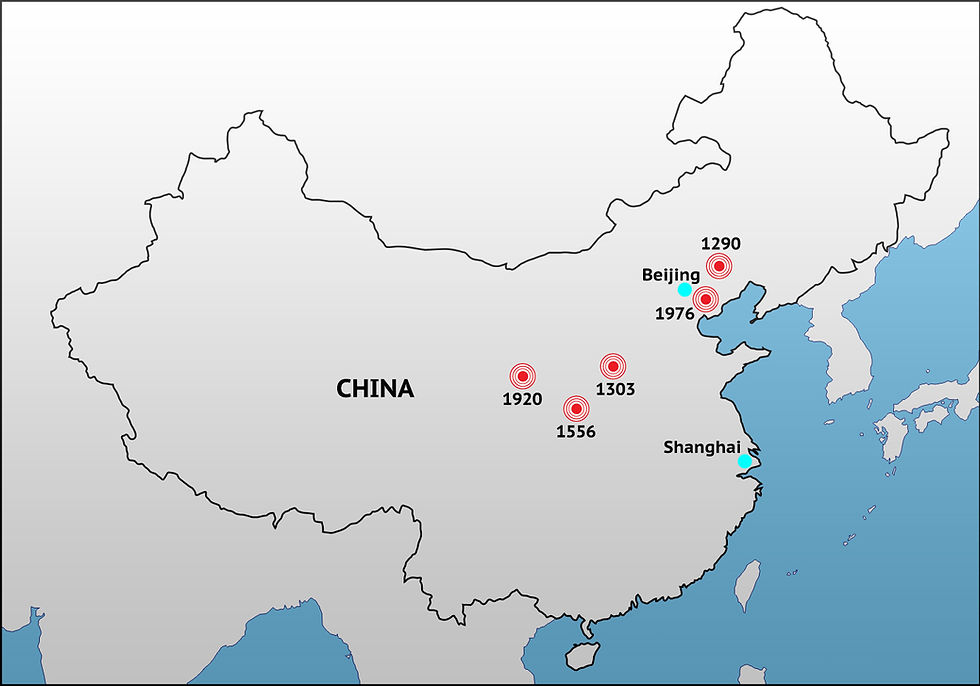Seeking Clues from China's Great Earthquakes
- cedillos5
- Apr 26, 2016
- 2 min read
Updated: Sep 28, 2020
Last week when earthquakes in Ecuador, Japan, and Myanmar lit up the news, I was in China learning more about the world’s deadliest recorded earthquake. I was reminded that disaster can still strike in the blink of an eye, just as it did in Sha’anxi Province 460 years ago.
The difference today is that we know earthquakes recur on faults. Understanding past events helps us find solutions that can protect people in places known to have hazards. That’s why we joined a team of China’s and Britain’s leading earth scientists who are studying catastrophic earthquakes that have struck central China.

Reviewing the locations of cities, active faults, and past large earthquakes in central China: Peizhen Zhang (left), Professor at Institute of Geology, China Earthquake Administration, and member of the Chinese Academy of Sciences; Barry Parsons (right), Professor of Geodesy and Geophysics, Oxford University.
China has suffered five of the fifteen deadliest earthquakes in recorded history. The most lethal happened in 1556 in Sha’anxi, the region at the end of the Silk Road. World population at the time was perhaps 500 milllion, and 830,000 people perished in that one event.
Dating back more than 2,000 years in China, survivors wrote of experiences in great earthquakes and the attendant landslides and aftershocks. To understand how future earthquakes will affect modern cities in central China, colleagues from China and the United Kingdom are reviewing these records and adding technical insights from recent geological field studies. GHI’s role in this collaboration is to help the team create a damage scenario that shows how a likely modern-day earthquake would impact one of these cities.

China is home to 5 of the world’s 15 deadliest recorded earthquakes, marked above with the year.
A damage scenario paints a picture of how people’s lives will suddenly change from a specific earthquake. It estimates buildings and infrastructure collapse; disruption of water and power; damage to schools and hospitals; and death and injury. It also includes an action plan that will reduce these risks. Our colleagues in China intend to learn the process and then prepare scenarios for additional cities at risk.
GHI has used damage scenarios around the world to help communities understand their vulnerabilities and the urgency to prepare. Drawing from diverse and historical research, this work serves ordinary people today, lots of them. Earthquakes will still strike in the blink of an eye, but communities can take steps, ahead of time, to protect people from harm.

Until May 3, donations to GHI will be matched dollar-for-dollar, thanks to a challenge grant from supporters above.
Our goal is to outwit disaster. Will you join the effort? GHI is participating right now in an online giving event. Until May 3, your donation will go twice as far to help the world’s most vulnerable communities prepare, thanks to generous supporters who put up a $25,000 fundraising match. If you “Like” GHI on Facebook, you can follow this event as well as our news from the field.
As always, I look forward to hearing from you.
Kind Regards,
Brian Tucker President, GeoHazards International P.S. You can read the damage scenarios and action plans that we developed for Quito, Ecuador; Guayaquil, Ecuador; Aizawl, India; Kathmandu, Nepal (Damage Scenario, Action Plan), ; Antofagasta, Chile; and Tijuana, Mexico.




Comments